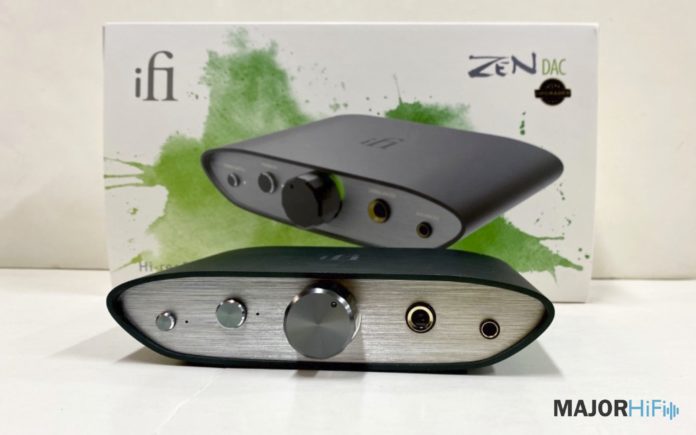iFi decided they had a few adjustments to make to their much-loved Zen DAC with the new upgraded Zen DAC V2. The original Zen DAC sat at a very low price point for its quality and build, and offered great clarity, consistency, and power to headphones. When looking at the brand new Zen DAC V2, it’s indistinguishable from its originator. However, while they may share the same build, there’s a reason iFi has decided to release a new iteration of this DAC/Amp. At $159, the upgraded Zen DAC sits slightly above the $129 price tag of the original. Let’s see what new features are being brought to the table with the Zen DAC V2. I did a video review of the Zen DAC V2, you can watch it here.
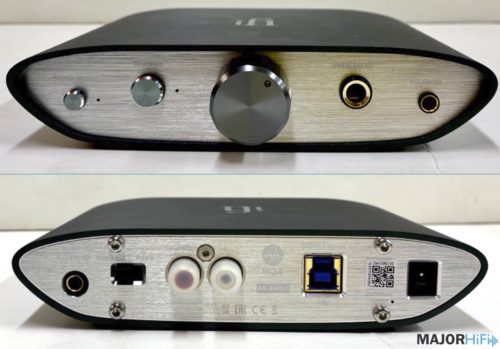
Build:
Both Zen DACs have identical outer builds, made of matte-black metal and having a relatively low profile and light weight. It’s not meant to be a pocket unit but would fit easily in any small bag. Both models have the same inputs and outputs. For outputs, we get two 4.4mm balanced Pentaconn outputs, a 6.3mm S-Balanced output, and an RCA analogue output. For inputs we have a USB audio and power input along with a DC 5V power input. We get a PowerMatch button, the high setting mostly for on/over ear headphones, namely those harder to drive, and the low setting geared towards IEMs. We also have a TrueBass button, which is an analogue circuit that is meant to compensate for any headphones with inadequate low end response. Finally, on the back we have a Variable/Fixed switch, which is to be used with the rear unbalanced 4.4mm and RCA outputs, either enabling or disabling the Zen DAC’s volume control.
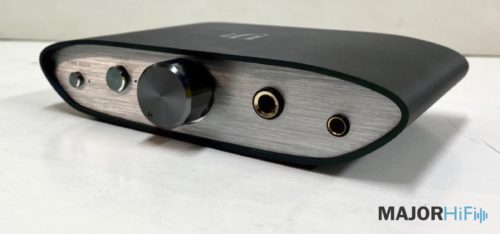
Design
Most elements under the hood of the Zen DAC V2 are the same as the original, with a few key differences. First, the Zen DAC V2 features an XMOS 16-Core chip to process audio data. This is in contrast to the 8-Core XMOS chip in the original Zen DAC. The doubling of the core power is meant to enhance processing power, clock speed, and memory. Second, it houses a low-jitter crystal clock, updated to provide >20dB better performance. One other important altercation is that thanks to its 16-core chip, the Zen DAC V2 is an MQA Decoder, instead of just an MQA Renderer like the original Zen DAC. If you’re using a source that doesn’t already decode MQA, the Zen DAC V2 has you covered.
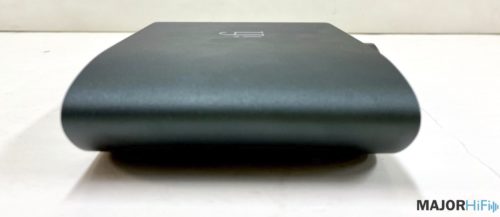
Sound
In the world of amps there’s a spectrum of transparency and coloring. Where your ears fall on that spectrum is of course a matter of taste, and each amp is made with a different intention. The main intention of both the original and updated Zen DAC seems to be transparency, clarity, and power. My original impression of the first Zen DAC was that it was ever so slightly colored. However, what seems more likely is that it’s so loyal to the sound of the original file that I’m hearing audio with so little added coloring, it sounds vaguely different from what I’m used to. That being said, it’s equally possible that both the Zen DAC and Zen DAC V2 have some very subtle coloring to them in addition to their high quality sound. The bottom line is that in terms of sound quality, you will be able to tell a difference when using the Zen DAC V2. However, in terms of sound signature, any differences are highly debatable, subjective, and hard to pin down. But, nonetheless, I will give you my perceived impressions of what I heard, and am not going to drive myself mad trying to decide which differences to pin on uninterrupted quality and which to pin, if any, on subtle coloring.
I found the imaging, detailing, and overall smoothness of the listen was noticeably better when using the Zen DAC V2 compared to your typical laptop or interface DAC. The headphones I tested this with were the Beyerdynamic DT 1990 Pro, Focal Celestee, HiFiMan Sundara, and Dan Clark Audio AEON 2 Open. On the DT 1990, listening to “Blow Away” by Kate Bush, there’s a lot of sparkling piano riffs, guitar plucks, high-hats, etc. It felt like the DT 1990 Pro was a lot more comfortable with the detail retrieval when using the Zen DAC V2. The layering felt more balanced and vivid. Listening to “Bloom” by Raveena on the Celestee, another great song for details and smooth translation, I loved not only how much cleaner and uncluttered the sound felt, but how seamless it was. Both the DT 1990 and Celestee felt like their sound had some of the harder edges shaved off a bit, especially in terms of sharp highs and high-mids. There were numerous times where I felt the Zen DAC V2 did a slightly better job on all of these fronts, namely the smoothing, than the original Zen DAC. This is likely due to the fact that the V2 has more optimal processing, as I mentioned.
For some already very clean-sounding headphones, the differences between the Sundara and AEON were especially nuanced. Listening to Cleo Sol’s “Perfect Blue,” the song’s jazzy percussion felt more dynamic and warm. The treble on both headphones felt slightly cleaned up, but this could also have been due to better detail retrieval and imaging. When sounds are getting more space to sit it creates a much clearer sound, so it’s hard to say if the treble was more present or if I was just able to pick it out more than I could before. Additionally, the AEON was one of the harder to drive headphones I tested this DAC with. While the PowerMatch button was certainly needed, after pressing that there was abundant volume available for the headphones. All the easier-to-drive headphones I used prior also rarely took more than halfway up on the volume knob to be plenty loud.
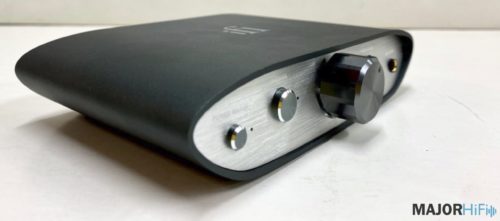
True Bass
The bass boost on this is the real deal. This is the one part of the Zen DAC V2 that is not subtle. The True Bass function adds a satisfying and even boost to your low end, and a strong one. For me, this strength felt well-executed as it was balanced and didn’t come across as too bell-shaped or low-mid disrupting. As I’m sure you’d expect, you’re not gonna want to use this function constantly, and it fits some headphones better than others and some songs better than others.
I’m a bass lover at large, so did leave the True Bass on a lot of the time. I’d constantly realize how long it had been on for and try turning it off only to find the sound felt lacking now by comparison. Back on it goes! The low end from this boost felt very clean and fairly tight. One of my best True Bass experiences was listening to “Haunted” by Beyoncé on the Focal Celestee. This incredibly produced and arranged song was completely leveled-up when I applied the boost, one might even call it a spiritual sound experience. Like the original Zen DAC, the performance of the low end boost on the Zen DAC V2 was one of its most attractive features, and at times the V2 felt to have slightly cleaner True Bass capabilities than the original Zen DAC.
Summary
If you want transparency with some light cleansing and arguably a few drops of color, the Zen DAC V2 is a great amp. While there are cheaper amps out there, the Zen DAC V2 competes with units well above its price point. I often found myself forgetting it wasn’t hugely expensive while testing it out. The upgrade from the original Zen DAC gives you more versatility by doing the decoding for you and giving you a wider choice of sources in addition to lowering the jitter. Yes, the differences in the Zen DAC V2 are not monumental, but it is a more perfected version of its predecessor. I appreciate that iFi is willing to circle back to their past creations and fine-tune them as opposed to constantly trying to create something new. It shows their aim is for quality over excessive novelty. If you’re in the market for a high-quality amp that won’t break the bank, the Zen DAC V2 is hard to pass up.
The Zen DAC V2 is available to purchase at Audio46.
Compare the ranking of various headphones, earbuds and in-ear monitors using our tools.
Discuss this, and much more, over on our forum.
---MAJORHIFI may receive commissions from retail offers.


